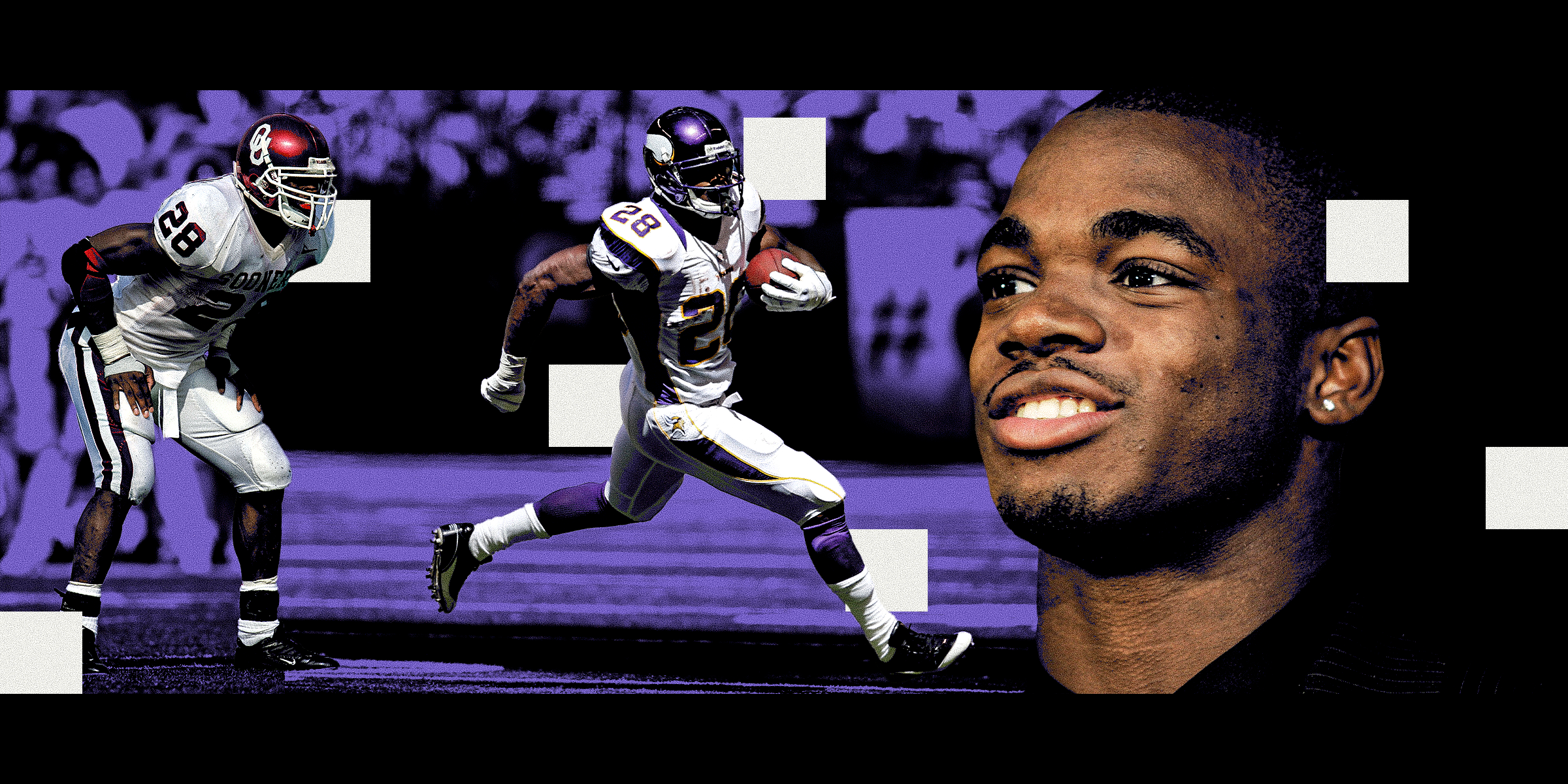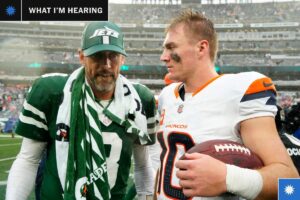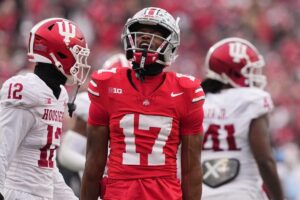
The private plane was mostly quiet. There was a nervous energy for the three Oklahoma football coaches onboard. They’d never done what they were about to do.
It was Sunday, Dec. 1, 2002, the first day coaches were allowed to visit high school juniors for recruitment. A day earlier, these coaches had been on the sideline as Oklahoma lost to in-state rival Oklahoma State, effectively dashing their hopes of appearing in the BCS national title game. But on this one-hour flight, they had other concerns.
As the plane neared Texarkana, an appropriately named border town sandwiched between Texas and Arkansas, they talked about the fact that none had never been to a prison before for a recruiting visit. “All I could relate it to was what I saw on TV and in the movies,” said Cale Gundy, Oklahoma’s running backs coach at the time. “We just didn’t know what it would be like.”
They also talked about the player who had them flying to visit a federal prison. He was good enough, they thought, to change an already successful program. But he would require a recruitment unlike any they’d ever experienced. Still, Adrian Peterson was worth it. Thus, the coaches headed to the federal prison where Adrian’s dad, Nelson, was incarcerated.
That flight marked the start of one of the wildest recruitments ever, a whirlwind two years where the top college programs battled for Peterson’s commitment and included a brief period when it was thought Peterson might skip college altogether and go straight to the NFL.
Peterson would eventually make it there and play 15 seasons. He was named NFL MVP in 2012 after an incredible comeback from an ACL tear. In 2014, he pleaded no contest to a misdemeanor charge of recklessly assaulting his son; he had used a “switch” to discipline the 4-year-old. He was put on probation, fined $4,000 and required to do 80 hours of community service. The NFL suspended him, but he returned in 2015 and won his third rushing title.
But before that, he was a coveted high school standout who arrived just as recruiting rankings were rising in popularity. Now, those rankings are obsessed over, followed and debated for years before players even commit to a school, evidenced by the hype around Wednesday’s opening of the early signing period. But Peterson was arguably the first true can’t-miss No. 1 prospect in the modern recruiting era, drawing coaches to the small town of Palestine in East Texas and one federal prison.
Said Gundy: “We knew it was going to be a battle all the way for him.”
Jeff Harrell came to Palestine High as the defensive coordinator and head track coach when Peterson was a sophomore. Peterson wasn’t on the varsity football team that year because he was academically ineligible. So Harrell didn’t work with Peterson until the track season that spring. Peterson’s mom, Bonita, was a former track star; his dad was a former college basketball player.
After the school’s first track workout, Harrell decided to have Peterson run on the team’s 4×100-meter relay team in addition to the 100- and 200-meter individual events. But Harrell encountered a problem. Harrell taught relay runners to stand 15 steps behind their starting mark to allow time to gather the baton from the previous runner while getting up to top speed. But when Peterson started running, the sprinters behind him with the baton couldn’t catch him. So Harrell had Peterson move up to 10 steps behind the starting mark. Then five.
“That didn’t work,” Harrell said.
So Peterson was told to stand at the starting mark until he received the baton. Harrell feared a collision. But each time, Peterson grabbed the baton and sprinted away so fast that, somehow, it worked.
“I remember going home every day and telling my wife, ‘I’ve got this kid and I’ve never seen anything like him in my life,’” Harrell said.
Peterson ran a 10.6-second 100-meter dash that year. He set a personal best of 10.26 seconds two years later, a time so fast that if it weren’t for football, Harrell believes Peterson could’ve become an Olympic sprinter.
Peterson played on both sides of the ball as a sophomore on the JV team, playing running back and outside linebacker, but as a junior on the varsity team, Harrell, by then the head coach, put an end to that. Harrell didn’t want to be the coach who got the country’s best football recruit hurt while playing out of position as a linebacker.
Peterson ran for 5,011 yards in his two varsity seasons. He averaged 11.7 yards per carry as a senior. He had 32 touchdowns. And he rarely played after halftime because his team was so dominant.
“I didn’t let him play any more than we needed and didn’t let him return any kicks or play defense,” Harrell said.
When Peterson’s high school career finally came to an end during a playoff loss his senior year, Harrell was filled with relief more than disappointment. “I just thought: Thank God I got through this and he didn’t get hurt,” Harrell said.
In East Texas, Petersons’ exploits were well known. Some members of opposing teams hung around the field after games in full uniform, sharpies in hand, waiting for Peterson to emerge from the locker room so they could get an autograph. But Harrell didn’t get a full grasp of Peterson’s celebrity until a trip together to Ohio after the season, where Peterson was going to be named the national offensive player of the year. As they waited together in the security line at the Dallas-Fort Worth airport, a TSA agent called them over.
“Before he shows an ID or anything, the man says, ‘Oh, you’re Adrian Peterson,’” Harrell said. “That was one of the first times it hit me that, ‘Oh man, everybody knows this kid.’”
At the Federal Correctional Institution Texarkana, guards asked the visiting Oklahoma coaches for their IDs and had them walk through a metal detector. They then guided the coaches to a picnic table in a vast courtyard. A water tower in the distance was the only obstruction against the vast East Texas sky.
Nelson came out and was joined by Bonita, Adrian and one of Adrian’s younger brothers. They talked about academics at Oklahoma (Nelson at one point had been committed to play basketball there) and the football program. Aside from the location, it was a normal recruiting visit.
“We sat out at that picnic table in the facility for a couple of hours,” Bob Stoops said. “They were fantastic to be with and visit with.”
Adrian told a few schools how important it was to ensure his dad, who was incarcerated when Adrian was 13 after being convicted on federal charges of laundering money acquired from the distribution of crack cocaine, was involved in the recruiting process.
“We had gone through all kinds of red tape for a couple months leading up to being allowed to get in and visit with them,” Stoops said. “So after that, other people tried. But because of all the logistics those people had to coordinate, (the other recruiters) said to heck with this, we’re not doing this anymore.”
USC had tried unsuccessfully to meet with Nelson. And while Peterson liked coach Pete Carroll and assistant coach Ed Orgeron, he wanted his dad to be able to watch his college games, which would’ve been tough if he chose USC. So Orgeron got resourceful.
“I tried to get the guy transferred to (a prison in) Los Angeles,” Orgeron said on “The Dan Patrick Show” last year. “Yeah, I tried. Couldn’t get it done, but I competed.”
Since Peterson didn’t play as a high school sophomore, some schools wanted to see him in person before believing the hype. When a Texas A&M assistant was led into the school and introduced to Peterson — 6-foot-1 and 210 pounds — wearing a sleeveless shirt and seemingly having muscles atop his muscles, Harrell said the coach uttered: “God almighty.”
Texas A&M offered Peterson a scholarship the next day.
Harrell advised Peterson to be polite and accommodating to every college coach who walked through the door. One day, the Oklahoma coaches visited the high school and had trouble locating Peterson. Eventually, he was found in an empty classroom with coaches from Texas A&M-Kingsville, a Division II school.
“He was being as nice as he could be, doing exactly what I told him,” Harrell said with a laugh.
In the spring of 2003, Peterson visited Oklahoma for the first time. The Sooners were two years removed from a national championship and were coming off a win in the Rose Bowl. They had no reason to change their shotgun offense that had resulted in so much success. But before the spring practice that Peterson attended, Gundy, the running backs coach, went over to offensive coordinator Chuck Long and told him: There’s this recruit, and he needs to see us running out of the I-formation. That’s his specialty.
“Well, we didn’t have any I-formation stuff,” Long said.
But he quickly installed a few new plays they could run in front of Peterson.
The Sooners were in their team hotel in New Orleans on Jan. 3, 2004. It was the night before their BCS national championship game against LSU. They were wrapping up a team meeting when quarterback Jason White saw the coaching staff celebrating. Peterson had just committed to Oklahoma on national TV.
“I’lI never forget seeing coach Gundy so excited jumping up and down,” White said. “And I was thinking to myself, ‘What just happened?’ And then I looked at the TV and I saw what was going on. So at that point, I was like, ‘Wow, this guy must be really, really good for coach Gundy to act like that right before the national title game.’”
On Oct. 29, 2003, Peterson watched LeBron James make his highly anticipated NBA debut, dropping 25 points as an 18-year-old. Two nights later, Peterson, who is three months younger than James, ran for 305 yards and six touchdowns on 17 carries in a home win over the Athens Hornets. He had touchdown runs of 46, 50 and 61 yards. Two days after that, Peterson was on the sideline for a Dallas Cowboys game, a guest of safety Roy Williams. “I’m having a great time,” Peterson told the Fort Worth Star-Telegram.
That September, Maurice Clarett sued the NFL over its rule that players aren’t eligible for the draft until they’ve been out of high school for three years. The suit, combined with James’ status as an 18-year-old in the NBA, opened the door for an obvious discussion: If Clarett wins his case, if there’s no age limit to enter the NFL, could Peterson make the jump straight to the league?
“Physically, there’s no doubt he could’ve,” Gundy said.
“Absolutely he could have,” Stoops said. “You look at him physically, he’s every bit any of them (in the NFL) even at 19 … But he’s a total outlier compared to everybody else. And that’s where when you open those kinds of rules up, now you’re going to have thousands of kids making bad decisions and it not working out for them. So just because one guy can do it doesn’t mean even 10 other guys could. They couldn’t.”
Peterson avoided the debate while in high school but later conceded he thought about making the jump. While he was with the Minnesota Vikings in 2015 (on his way to a third NFL rushing title), Peterson said in a conference call with reporters: “Not to sound cocky or anything, but yeah, I do feel like I could have come out my senior year of high school and played in the NFL.”
Instead, Peterson arrived at Oklahoma in 2004. The first day of fall camp was used for physical testing and conditioning before putting pads on and practicing on the second day. Coaches put Peterson in a group with White, the quarterback coming off a Heisman Trophy-winning season.
“Adrian walks in, and he’s in these tight biker shorts and a cutoff shirt,” White said. “And we’re all like, ‘Oh, that must be a juco transfer.’ I mean, the dude looked like he’d already played in college for four years.”
The testing started with down-and-backs, 100 yards to the opposite end zone, then back. On the first run, Peterson finished in front by 20 yards. The second, it was 30 yards. Upperclassmen started getting mad that the true freshman was showing them up.
“I can remember seeing (strength coach) Jerry Schmidt in the locker room that day saying that AD measured in at 6-foot-2, 216 pounds, and ran a 4.38 (40-yard dash),” Gundy said. “That got everybody’s attention — especially the older guys.”
The upperclassmen figured he’d slow down when pads came on the next day. That’s how it usually went for freshmen. Instead, Peterson took his first carry for a touchdown, the start of a dominating practice. “We knew right then we had a superstar,” Long said.
That freshman season for Peterson was White’s sixth at Oklahoma. He had just won the Heisman. Still, he would have to adjust to the talented freshman now sharing the backfield. White dreaded a few play calls — 18 stretch and 19 stretch. They were rushes out wide off the tackle. White had to sprint out of his stance just to get the ball in Peterson’s arms.
“I used to cringe because my biggest fear was I wasn’t going to be able to get him the ball because he was so fast,” White said. “I probably gave the play away every time we ran it because I felt like I had to get in a special stance under center just to be able to get to Adrian.”
Oklahoma initially taught their running backs to stand 7.5 yards behind the ball. But Peterson reached the line too quickly. He was running into his linemen before they had a chance to reach their blocks. So, coaches told Peterson to stand 9 yards behind the ball.
“That and pass protection are the two things that I worked the hardest with him on for three years,” Gundy said. “Like, I know what you do when you get the ball. But you’ve got to have to learn to have some pace and things will get even easier for you.”
Still, Peterson’s 2004 season is considered one of the greatest ever by a true freshman. He ran for 1,925 yards in 13 games that season. He averaged more than a touchdown per game (15 total) and 5.7 yards per carry. He notched more than 100 rushing yards in each of his first nine collegiate games. He finished second in Heisman voting while presumably splitting votes with White, who finished third. (USC’s Matt Leinart won.)
“That’s why his daddy named him AD — All Day,” Gundy said. “Everything that he did, he was the very best.”
Peterson was a star again in 2005, rushing for 1,104 yards and 14 touchdowns. A year later, as a Heisman front-runner, Peterson opened the season as one of the nation’s top rushers, gaining 100 yards or more in each of the first five games. Before the sixth game, Nelson Peterson was released from an Oklahoma City halfway house. Peterson called it “a real big deal” to get to play in front of his dad for the first time since he was 12.
Against Iowa State with his dad in the stands, Peterson totaled 228 yards of offense and two touchdowns. But on his last carry, a 53-yard touchdown run, Peterson broke his collarbone diving into the end zone, ending his regular season and leaving him just shy of Oklahoma’s all-time rushing record held by Billy Sims.
Peterson was the seventh pick in the 2007 draft. He led the league in rushing three times, and his 14,918 all-time rushing yards are the fourth most in league history. He hasn’t officially retired, but he hasn’t played in a game since the 2021 season ended.
Earlier this year, he sent a long video to Harrell. He thanked him for all their work together. The two connected and chatted about those crazy days in high school with opponents asking for autographs and college coaches lining up outside the school. They also recalled all the games Peterson exited early, discussing how large the legend of Adrian Peterson might have been had Harrell let him play more.
Said Harrell: “I told him, you could’ve set records that would be there forever.”
(Illustration: Sean Reilly / The Athletic; photos: Ronald Martinez, Joe Robbins / Getty Images; Mike Ehrmann / WireImage)
“The Football 100,” the definitive ranking of the NFL’s best 100 players of all time, is on sale now. Order it here.





